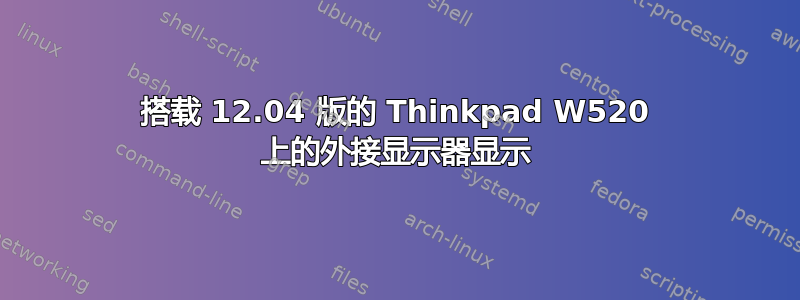
我知道有很多关于这些问题的资料,但其中很多似乎已经过时,而且似乎没有什么适合我的情况:
- ThinkPad W520(Intel 3000 和 Nvidia 1000M 芯片组)
- 操作系统:Ubuntu 12.04.3。
- BIOS 显卡设置:
Optimus - BIOS OS Optimus 自动检测:
disabled
我使用下面的 Bumblebee wiki 来安装和设置 Bumblebee: https://wiki.ubuntu.com/Bumblebee#安装
将我的显卡 BusID 设置为“PCI:01:00.0”(参见下面的配置文件)后,我能够运行optirun firefox并进行 virtualgl 测试,如optirun glxspheres64和glxspheres64。因此,我相信 Bumblebee 安装一切正常,只是我无法连接到我的外接显示器(通过 VGA)。关于如何做到这一点,您有什么想法吗?W520 的 VGA(和 DisplayPort)硬连线到 Nvidia 卡,如 Zachary Sunberg 所述:
http://zachstechnotes.blogspot.com/2012/04/post-title.html
因此,我相信这会让尝试将 VGA 连接到外部显示器时变得有点棘手。我相信我必须使用服务器/屏幕克隆,如下面记录的我的尝试中所述:
我尝试了以下帖子来配置外接显示器,
http://hillspcworld.com/forum/index.php?topic=2.0
但是在第 7 步之后重新启动会导致操作系统完全崩溃(引导加载程序后出现黑屏,显示“无法写入字节:管道损坏”)。我相信这是由于 xorg 服务器以某种方式破坏了我的系统。
我在以下教程中尝试了类似的方法,但是在安装 xorg-dev 后重新启动时出现了与 (1) 相同的崩溃:
http://sagark.org/optimal-ubuntu-graphics-setup-for-thinkpads/
截至目前,我不知道接下来该怎么办。我有几个线索,您对问题是什么或我能做什么有什么想法吗?还有更好的建议吗? http://zachstechnotes.blogspot.com/2012/04/post-title.html
https://github.com/Bumblebee-Project/Bumblebee/issues/77
https://github.com/Bumblebee-Project/Bumblebee/issues/522
此外,这里是我的部分文件(如果有更好的配置请告诉我 - 我做的唯一更改是取消注释文件中的“BusID PCI:01:00.0”)xorg.conf.nvidia:
lucas@lucas-ThinkPad-W520:~$ more /etc/bumblebee/xorg.conf.nvidia
Section "ServerLayout"
Identifier "Layout0"
Option "AutoAddDevices" "false"
Option "AutoAddGPU" "false" EndSection
Section "Device"
Identifier "DiscreteNvidia"
Driver "nvidia"
VendorName "NVIDIA Corporation"
# If the X server does not automatically detect your VGA device,
# you can manually set it here.
# To get the BusID prop, run `lspci | egrep 'VGA|3D'` and input the data
# as you see in the commented example.
# This Setting may be needed in some platforms with more than one
# nvidia card, which may confuse the proprietary driver (e.g.,
# trying to take ownership of the wrong device). Also needed on Ubuntu 13.04.
BusID "PCI:01:00:0"
# Setting ProbeAllGpus to false prevents the new proprietary driver
# instance spawned to try to control the integrated graphics card,
# which is already being managed outside bumblebee.
# This option doesn't hurt and it is required on platforms running
# more than one nvidia graphics card with the proprietary driver.
# (E.g. Macbook Pro pre-2010 with nVidia 9400M + 9600M GT).
# If this option is not set, the new Xorg may blacken the screen and
# render it unusable (unless you have some way to run killall Xorg).
Option "ProbeAllGpus" "false"
Option "NoLogo" "true"
Option "UseEDID" "false"
Option "UseDisplayDevice" "none"
新型驱动程序:
lucas@lucas-ThinkPad-W520:~$ more /etc/bumblebee/xorg.conf.nouveau Section "ServerLayout"
Identifier "Layout0"
Option "AutoAddDevices" "false"
Option "AutoAddGPU" "false" EndSection
Section "Device"
Identifier "DiscreteNvidia"
Driver "nouveau"
# If the X server does not automatically detect your VGA device,
# you can manually set it here.
# To get the BusID prop, run `lspci | egrep 'VGA|3D'` and input the data
# as you see in the commented example.
# This Setting is needed on Ubuntu 13.04.
# BusID "PCI:01:00:0"
大黄蜂配置:
lucas@lucas-ThinkPad-W520:~$ more /etc/bumblebee/bumblebee.conf
# Configuration file for Bumblebee. Values should **not** be put between quotes
## Server options. Any change made in this section will need a server restart
# to take effect. [bumblebeed]
# The secondary Xorg server DISPLAY number VirtualDisplay=:8
# Should the unused Xorg server be kept running? Set this to true if waiting
# for X to be ready is too long and don't need power management at all. KeepUnusedXServer=false
# The name of the Bumbleblee server group name (GID name) ServerGroup=bumblebee
# Card power state at exit. Set to false if the card shoud be ON when Bumblebee
# server exits. TurnCardOffAtExit=false
# The default behavior of '-f' option on optirun. If set to "true", '-f' will
# be ignored. NoEcoModeOverride=false
# The Driver used by Bumblebee server. If this value is not set (or empty),
# auto-detection is performed. The available drivers are nvidia and nouveau
# (See also the driver-specific sections below) Driver=
# Directory with a dummy config file to pass as a -configdir to secondary X XorgConfDir=/etc/bumblebee/xorg.conf.d
## Client options. Will take effect on the next optirun executed. [optirun]
# Acceleration/ rendering bridge, possible values are auto, virtualgl and
# primus. Bridge=auto
# The method used for VirtualGL to transport frames between X servers.
# Possible values are proxy, jpeg, rgb, xv and yuv. VGLTransport=proxy
# List of paths which are searched for the primus libGL.so.1 when using
# the primus bridge PrimusLibraryPath=/usr/lib/x86_64-linux-gnu/primus:/usr/lib/i386-linux-gnu/primu s
# Should the program run under optirun even if Bumblebee server or nvidia card
# is not available? AllowFallbackToIGC=false
# Driver-specific settings are grouped under [driver-NAME]. The sections are
# parsed if the Driver setting in [bumblebeed] is set to NAME (or if auto-
# detection resolves to NAME).
# PMMethod: method to use for saving power by disabling the nvidia card, valid
# values are: auto - automatically detect which PM method to use
# bbswitch - new in BB 3, recommended if available
# switcheroo - vga_switcheroo method, use at your own risk
# none - disable PM completely
# https://github.com/Bumblebee-Project/Bumblebee/wiki/Comparison-of-PM-methods
## Section with nvidia driver specific options, only parsed if Driver=nvidia [driver-nvidia]
# Module name to load, defaults to Driver if empty or unset KernelDriver=nvidia-current PMMethod=auto
# colon-separated path to the nvidia libraries LibraryPath=/usr/lib/nvidia-current:/usr/lib32/nvidia-current
# comma-separated path of the directory containing nvidia_drv.so and the
# default Xorg modules path XorgModulePath=/usr/lib/nvidia-current/xorg,/usr/lib/xorg/modules XorgConfFile=/etc/bumblebee/xorg.conf.nvidia
## Section with nouveau driver specific options, only parsed if Driver=nouveau [driver-nouveau] KernelDriver=nouveau PMMethod=auto XorgConfFile=/etc/bumblebee/xorg.conf.nouveau
谢谢。
答案1
首先,我不再尝试使用 12.04.3 或 12.04.4 LTS,而是改用 13.10。我认为 LTS 版本实际上无法跟上不断变化的图形情况 - 这是我所学到的惨痛教训。
以下是我采取的一般步骤:
1) Install latest intel drivers, hope that intel-virtual-output, which is the integrated version of screenclone. If it's not packaged, compile that stuff from source.
2) In your xorg.conf.nvidia ensure the option preventing external screens is disabled.
3) Xrandr as usual :)
此资源很有帮助:
我还针对 Ubuntu 14.04 的这个问题创建了一篇博客文章:
http://blog.lukeswart.net/wordpress/
后者还应该包含有助于初学者从源代码编译驱动程序的信息。
附言:作为一名 Linux 新手,这个过程非常耗时,我只能希望这篇文章能对某些人有所帮助。对于 Linux 新用户来说,在运行 Optimus 的笔记本电脑上设置外接显示器(其显示端口硬连线到 Nvidia 芯片)是一个非常令人沮丧的过程。
作为一名需要在工作中使用 Linux 的用户,这种保护专有 Optimus 驱动程序的整个情况让整个技术社区感到尴尬。


